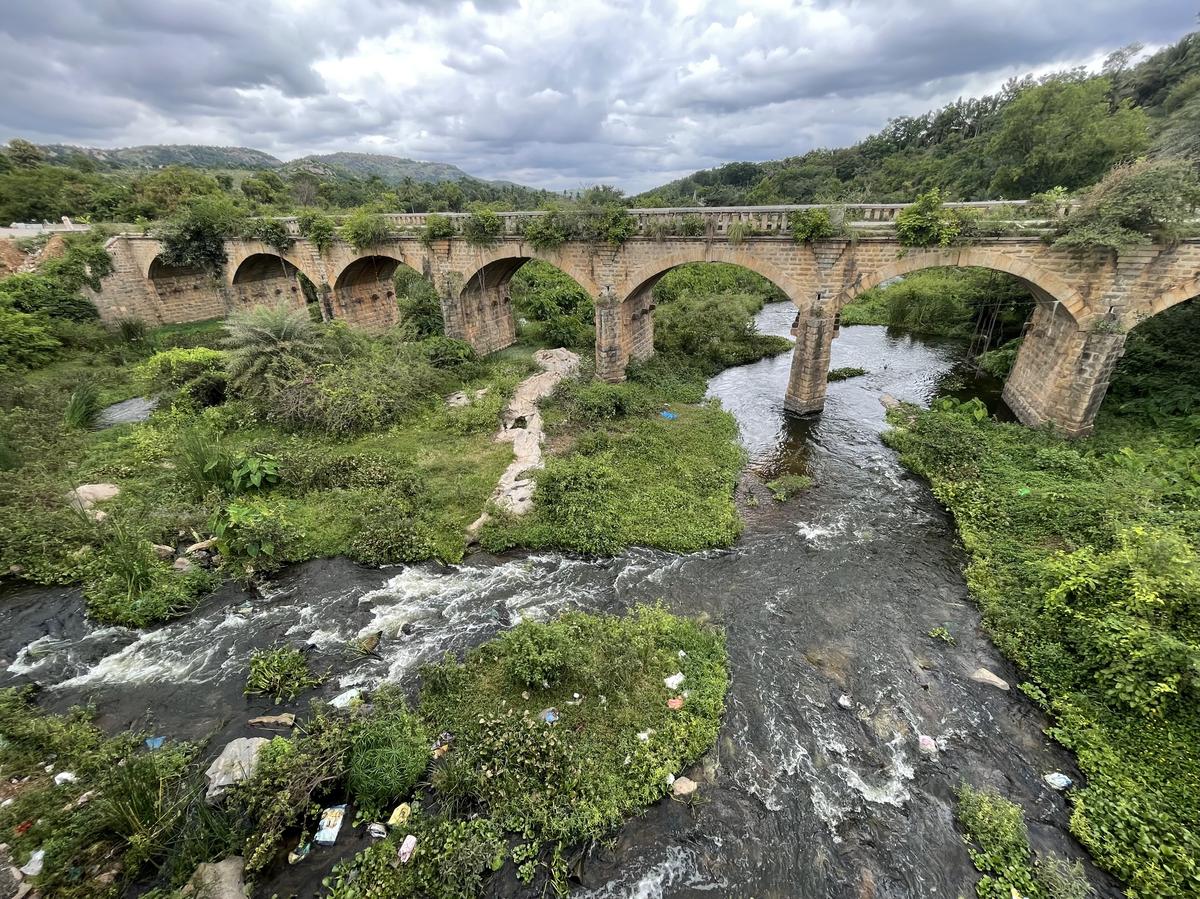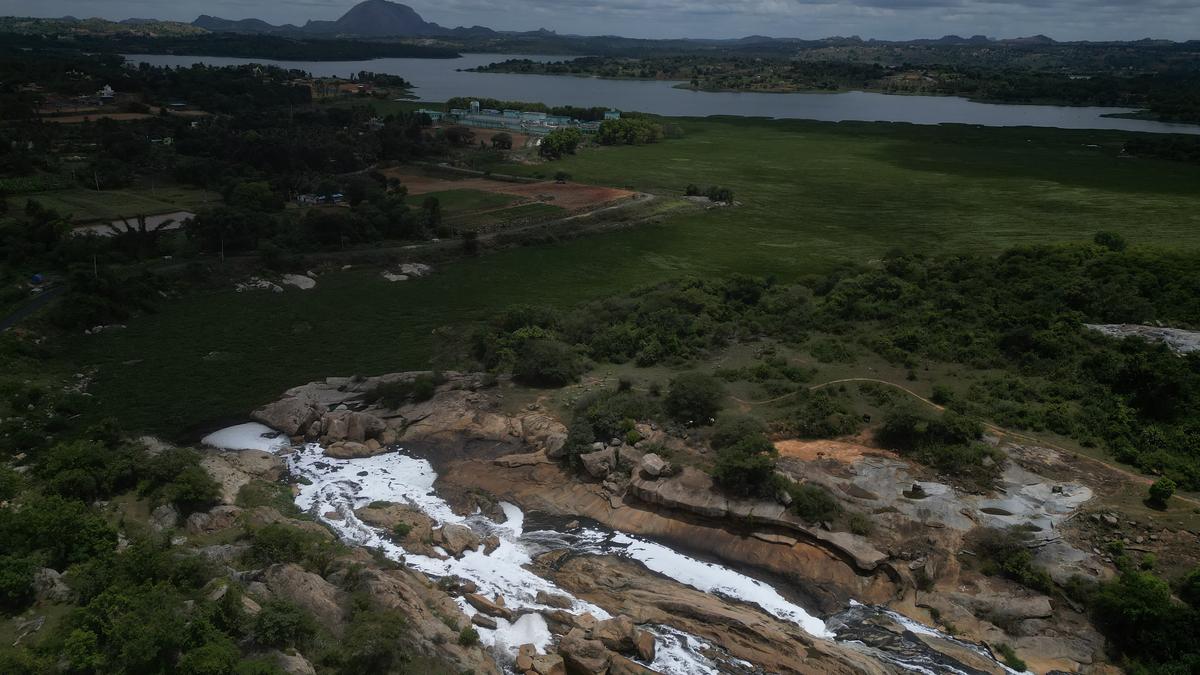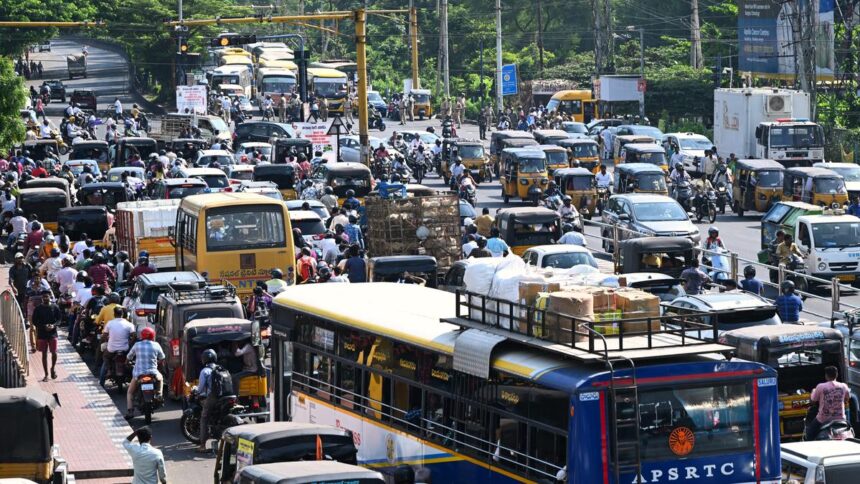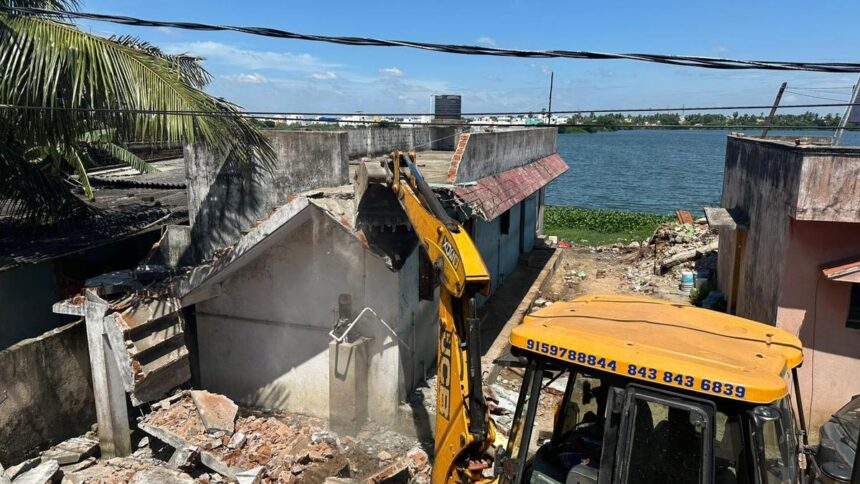As the clouds play hide-and-seek and the sun beats down in mid-July, in what has been a dry southwest monsoon for Bengaluru thus far, waters of the Arkavati river, unsettlingly black, flows its course on the outskirts of the city.
Jayaram, 60, a resident of Jogerahalli, close to the Thippagondanahalli (T.G. Halli) reservoir, is walking around in the quaint village as devotional songs play out of a speaker from a nearby temple. Two class 5 students of a government school hang around him as he tells The Hindu, “Until a few years ago, we used to wash clothes in the river. They started letting polluted water in from everywhere. What flows now is acid water. We cannot even step into it. There is an odour and froth. Some are brave enough to use it for agriculture.”
He recalled that, when he was around 30 years old, he would drink water from the river and wash clothes in it. “When it rains, we see some clean water briefly, and then the black water comes again. The water is of no use to anyone, not even to animals,” he says.
Ballyamma, 60, at the nearby Varthur Narasimhapura, was watching over her grazing goats close to a pumping station. “I came here after getting married 40 years ago, and I remember we used to drink this water and cook with it. It has been at least 15 years since we stopped using it. It smells,” she says, adding that they use borewell water for their daily needs.
Once a drinking water source
Once the primary source of drinking water for Bengaluru — from 1936 to 2000, according to the Bangalore Water Supply and Sewerage Board (BWSSB) — the Arkavati is today what one research called “a ghost river”, a shadow of its former glorious self.

In June 2025, the Karnataka government announced a high-level committee of experts to spearhead the rejuvenation of the Arkavati through a public-private partnership model.
| Photo Credit:
K. MURALI KUMAR
Over two-and-a-half decades later, in June 2025, the Karnataka government announced a high-level committee of experts to spearhead the rejuvenation of the Arkavati through a public-private partnership (PPP) model. The BWSSB, while announcing the plan, said, “Stretching 53 km from Nandi Hills to T.G. Halli, and covering a basin area of 1,400 sq. km, the Arkavati holds immense potential to be reborn as a sustainable lifeline.”
BWSSB Chairman Ram Prasath Manohar, while announcing the plan, said water from the Yettinahole project (which envisages the diversion of west-flowing river water to meet the drinking water needs of seven parched districts in the south Karnataka region) was intended to mix with the Arkavati waters at T.G. Halli, but rapid industrial growth, wastewater discharge, and environmental degradation rendered the reservoir’s water unfit for consumption. While admitting that only 15% of the Arkavati’s river basin falls under the BWSSB’s jurisdiction, he also said that several government agencies, NGOs, and civic bodies were coming together to shape a comprehensive action plan.
Arkavati river
Originates at Nandi Hills in Chickballapur district
Joins the Cauvery at Sangama in Bengaluru South (formerly Ramanagara) district
Length of the river: 170 km
It traverses through four districts
Chickballapur, Bengaluru Rural, Bengaluru Urban, and Bengaluru South
It has three tributaries
Kumudavati, Suvarnamukhi, Vrishabhavati
Source: BWSSB
The BWSSB also announced that Infrastructure Development Corporation (Karnataka) Ltd. has already begun an integrated study covering areas such as Hesaraghatta, Madanayakanahalli, and parts of the Bruhat Bengaluru Mahanagara Palike (BBMP), laying the groundwork for rejuvenation.
Stakeholder meeting
According to a BWSSB document on the ‘Rejuvenation of Arkavathy River up to TG Halli’, from the origin of the river at Nandi Hills, till Doddaballapur town, the stream is less polluted, barring drain water entry and dumping of solid waste.
“Municipal sewage from Doddaballapur town enters into the Nagara Kere (lake) and polluted industrial wastewater enters from Bashettyhalli Industrial Area at Veerapur into the river,” says the document, adding that once the river crosses Doddaballapur town and enters Bengaluru Rural, the river is in “a highly stressed state due to pollution from rapid urbanisation and industrialisation”.

The document also acknowledges that as the river traverses, it accumulates various pollutants, including untreated sewage and industrial waste, leading to poor water quality in T.G. Halli, and that the water is not useful for drinking or any other domestic purposes.
The BWSSB has planned to take up the rejuvenation of the Arkavati from Nandi hills to T.G. Halli (54 km) “to make the river pollution-free”.
The document lists views and recommendations from multiple stakeholders of the river, one of which is the Bangalore Development Authority (BDA), as the Dr. Shivaram Karanth Layout is in the Arkavati catchment area. “It is necessary to know the disposal scheme of the wastewater generated from the layouts developed by the BDA in the Bengaluru region,” it says.
Questionable policy decisions
But is it going to be possible? Experts who have conducted studies on the river say it is not going to be easy. Sharachchandra Lele, Distinguished Fellow in Environmental Policy and Governance, Centre for Environment and Development, Ashoka Trust for Research in Ecology and the Environment, says “rejuvenation” is a tricky concept.
According to a BWSSB document, once the river crosses Doddaballapur town and enters Bengaluru Rural, Arkavati river is in ‘a highly stressed state due to pollution from rapid urbanisation and industrialisation’.
| Photo Credit:
K. MURALI KUMAR
“If it means the natural flow should come back, that will require major changes in groundwater use in the upstream, which looks very difficult. If it means making the river flow ‘anyhow’, then the idea of putting Yettinahole water into T.G. Halli will make it look like the Arkavati has been ‘rejuvenated’, but will it really solve any problem? We must also ask, ‘rejuvenation for whom?’ Do we want the Arkavati to be a ‘boating place’ or a ‘scenic riverside’ for urban folks, or a source of water and cultural value for agricultural households?” he asks.
In a study published in January 2013, titled ‘Water management in Arkavathy basin: A situation analysis’, of which Lele was one of the authors, it was stated that the decline of the Arkavati’s flow into T.G. Halli reservoir was directly caused by the expansion of eucalyptus cultivation and increased groundwater pumping in the T.G. Halli catchment area.
“It has been aggravated by the construction of an excessive number of check dams and other structures on the various streams that feed the Arkavati, which resulted in further reductions in surface flows, but did not augment baseflows as the groundwater withdrawal remained unregulated,” explains Lele. The changes in cropping, such as the growth of eucalyptus and shift to groundwater-irrigated horticulture and vegetable farming, are the result of government incentives, as well as market pressures (rising demand from Bengaluru), and also the result of changing labour availability as labour migrated to Bengaluru, he says.
“While many of the changes are expected in an area close to a city, lack of a governance mechanism around groundwater and, in fact, around integrated management of water resources as a whole is the key missing policy piece. The benefits of groundwater over-exploitation have gone disproportionately to the rich farmers, as poorer farmers could not afford to dig borewells, or abandoned them after they failed, as groundwater levels dropped,” he says, adding that the State agency in charge of T.G. Halli reservoir (the BWSSB) lost interest in the inflow decline problem, because it shifted to the Cauvery as the only source that they think will serve all of Bengaluru’s water needs.
Results of pollution testing
A more recent report, ‘Uncovering the hidden pollution in the Arkavathi – Emerging contaminants impacting Bengaluru & beyond,’summarises the results of pollution testing along the river conducted by Paani.Earth, in collaboration with the International Centre for Clean Water, IIT Madras, in February and March 2024. Paani tested samples for 65 unique water and 20 unique sediment pollution parameters and compared the testing results to national and international standards and guidelines for freshwater and sediment pollution.

The report states that every single test site exhibited pollution values above national and international standards and guidelines. “Even remote areas with no visible pollution had high levels of persistent pollutants, highlighting the river’s vulnerability to long-range contamination. Across test sites, Paani observed notable spikes in pollution levels, frequently downstream of industrial areas or other zones with known pollution discharges. Additionally, the results demonstrated that high levels of pollutants from Urban Bengaluru enter the Arkavati via the Vrishabhavati and degrade water quality. Many of the river sites had high phosphorus levels, causing eutrophication,” states the report.
“Currently, our rivers are graded A to E based on just a handful of parameters like pH, dissolved oxygen, coliform bacteria, and a few others to decide if the water is ‘fit’ for drinking, bathing, irrigation, or industrial use. But these grades don’t take into account many persistent and harmful chemicals that remain in the water and soil. As a result, water can still be carrying dangerous contaminants like hexavalent chromium and yet be reported as ‘safe for irrigation’ just because it meets those limited criteria,” says Madhuri Mandava, who, along with Khushbu K. Birawat, both from Paani, accompanied The Hindu on the site visit to the Arkavati.
According to a study, the decline of the Arkavati’s flow into T.G. Halli reservoir is directly caused by the expansion of eucalyptus cultivation and increased groundwater pumping in the catchment area.
| Photo Credit:
K. MURALI KUMAR
She adds that the instruments used are not sensitive enough to pick up dangerous chemicals in lower concentrations, which means harmful contamination can go completely unnoticed and unreported, while the same water continues to irrigate the food we eat.
First things first
Lele says it is unlikely that the river will ever flow again “as it did in the past”, and that this “past flowing river” itself is a myth. “We must remember that even 200 years ago, there were probably 400 irrigation tanks blocking streams in the T.G. Halli catchment and that water was used to cultivate sugarcane/paddy. It is best to aim for sustainable and equitable water use in the T.G. Halli catchment and avert water pollution in the reservoir, because the Kumudavati is still contributing inflow. Bengalureans really do not stand to benefit from its rejuvenation, unless the idea is for T.G. Halli dam to start supplying water again, which seems very unlikely,” he says.
Birawat is more optimistic. “The first step to healing our rivers is to see what is really hurting them and identify the sources. The Central Pollution Control Board’s 2017 guidelines for water quality monitoring laid out a robust framework to help understand pollution sources, trends, and the effectiveness of control measures. But on the ground, implementation by the Karnataka State Pollution Control Board falls short of this intent. Monitoring has been reduced to a simplistic grading exercise, with little evidence of meaningful classification of stations or comprehensive testing. As a result, the programme fails to guide corrective action or improve water quality, and risks, leaving the most critical pollution sources unaddressed,” she says.
She also says no matter how much we clean the Arkavati, it will not make a real difference if the Vrishabhavati keeps pouring pollution into it.
A river, she points out, is just not water; it is a living ecosystem. “A river is so much more than just a line of water between two banks. It reflects everything around it — the forests, the lakes, the built-up areas, the storm-water drains, the floodplains, the fields, the hills, and the aquifers underground. It does feel too little and too late, when you see the pathetic state of the river, but better late than never. If we truly wish to rejuvenate the Arkavati, we must also protect its catchment. It feels deeply counterintuitive when, on one hand, committees are set up to revive the river, yet on the other, the government proposes to dilute its buffer zones and weaken the T.G. Halli preservation notification,” she adds.
(Edited by Giridhar Narayan)






















